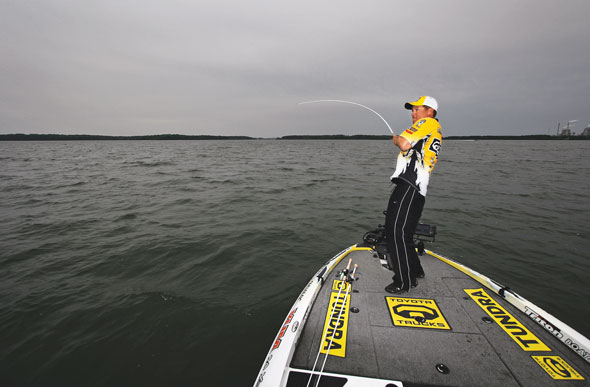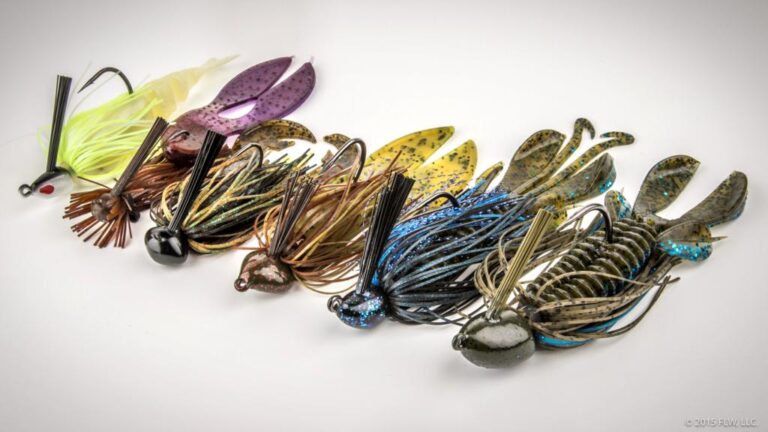How to Set the Hook on a Bass

To set the hook on a bass, snap the rod upward quickly after you feel a bite. Ensure your line is taut before jerking to maximize the hook’s penetration.
Setting the hook effectively is crucial for a successful bass fishing experience. Feel the bite, and without hesitation, a swift upward motion of the rod will secure the fish. This fundamental skill requires timing and precision, ensuring the bass doesn’t escape with your bait.
Seasoned anglers know this moment is critical: react too slowly, and the bass may spit out the hook; too forcefully, and you risk breaking the line or tearing the fish’s mouth. Mastering the technique of setting the hook can significantly increase your catch rate and add to the thrilling excitement of reeling in a big bass. With practice, any angler can turn bites into impressive catches.
Introduction To Bass Fishing
Bass fishing is a thrilling outdoor sport. Angling for bass can be exciting and rewarding. These fish are known for their fighting spirit and sudden jumps out of the water.
Bass are unique because of their behavior and habitat. They often hide near structure like logs. This makes catching them a fun challenge.

Credit: m.youtube.com
Equipment Essentials
Selecting the right rod for bass fishing is vital. Balance and flexibility are key qualities. Your rod should have enough backbone to handle bigger fish, yet be flexible for casting lures. Look for a rod that’s 6 to 8 feet in length. Make sure it aligns with your preferred fishing style.
Choosing your line and hook looks simple, but it’s critical. A monofilament line is great for beginners. Advanced anglers might opt for braided or fluorocarbon lines. Hooks should be sharp and the right size for the bass you target. Smaller hooks are better for finesse, larger hooks for bigger baits.
Understanding Bass Behavior
Bass thrive in specific habitats, seeking areas with abundant cover and forage. Structured environments like weed beds, sunken structures, and drop-offs are prime spots. Effective anglers map these zones to predict bass locations.
Seasons dictate bass movement and feeding habits. Warmer months see active feeding near surfaces, while cooler temperatures drive bass to deeper waters. Understanding these patterns is crucial for timing your hook set to match bass behavior.
- Spring: Bass move to shallows for spawning, feeding actively.
- Summer: Look for bass around cover in both deep and shallow waters.
- Fall: Bass feed heavily, preparing for winter. They’re often near shore.
- Winter: Bass slow down, staying in deeper, stable environments.
Techniques For Setting The Hook
Knowing the right moment to set the hook is crucial in bass fishing. An early or late hook set can lead to losing the fish. To find the perfect timing, pay close attention to the feel of the line and the movements of the rod tip. A sudden tug or dip often signals the bass has taken the bait.
To ensure a solid hook-set, keep the line taut, and once you sense the fish, snap the rod up firmly. The goal is to pierce the hook into the fish’s mouth securely. Use a swift, yet controlled motion to avoid tearing the hook out. For a successful catch, timing and technique work hand in hand.
- Maintain constant tension on the line.
- Watch the rod tip for unusual movements.
- Set the hook with a quick upward motion.
Common Mistakes To Avoid
Knowing your hook type is key. Each hook type has a different shape. They also have unique sharpness. Your hook choice should match the bait you use. Not all hooks fit all bait types.
Line tension is crucial when setting the hook. Keep the line tight enough. A slack line might miss the strike. But, too much tension can break the line. Find a balance to feel the bass bite.

Credit: m.youtube.com
Practicing Your Hook Set
Mastering the hook set for bass fishing takes practice. Creating simulated scenarios at home can build your skill. Practice by setting up targets in your yard. Pretend these targets are bass. Use your fishing rod to cast towards them. As the lure hits the target, practice snapping the rod upwards. This action mimics the real hook set. It’s important to get the feel of it. Over time, you’ll learn the right amount of force needed to set the hook without breaking the line or losing the fish. Real-life experiences on the water are also crucial. Pay attention to every bite. Timing is key. Too early, and the bass might not have fully taken the lure. Too late, and it might spit it out. Each catch provides valuable lessons for honing your technique.
Advanced Strategies
Stealth and silence play a crucial part in successfully hooking a bass. Movement or sound can alert the fish, leading to a missed opportunity. Approaching your fishing spot with minimal disturbance ensures that bass remain unaware of your presence.
Adapting to water conditions is key. Clear waters require a more delicate approach, using lighter lines and subtler techniques. Murky waters allow for a bolder style. Variations in light and shadow can impact bass behavior, dictating different strategies. Quick observations and adjustments maximize your chances.

Credit: www.onthewater.com
Conservation And Ethical Angling
Catch and release practices ensure bass populations thrive. Use barbless hooks to minimize injury. Handle fish with wet hands to protect their slime coat. Support the bass horizontally when out of water. Quick release back into the water is crucial.
Remember, sustainable fishing impacts our ecosystems positively. Teach young anglers about respecting nature. Follow local regulations and guidelines strictly. These actions safeguard bass for future generations. Let’s cherish our aquatic wildlife!
Frequently Asked Questions Of How To Set The Hook On A Bass
How Do You Know When To Set A Hook?
You should set a hook when you feel a fish nibble or see your fishing line move, indicating a fish has taken the bait.
How Do You Set The Hook On A Bass Pro?
To set the hook on a bass, reel in slack line, then snap the rod upward firmly. Maintain tension and control the fish’s runs with steady pressure.
What Is The Best Hook Setup For Bass Fishing?
The best hook setup for bass fishing is a Texas-rigged soft plastic with a 4/0 EWG hook, suited for weedless presentations.
How Do I Get Better Hook Sets?
To improve hook sets, keep your line taut and react swiftly to bites. Use sharp hooks and set the hook firmly with a quick, decisive motion. Match hook size with your bait for optimal results.
Conclusion
Mastering the art of setting the hook is crucial for any bass fishing enthusiast. With practice and persistence, your catch rate will soar. Remember to match your technique to the bait and react swiftly to the bass’s bite. Tight lines and happy fishing – your next trophy bass awaits!


